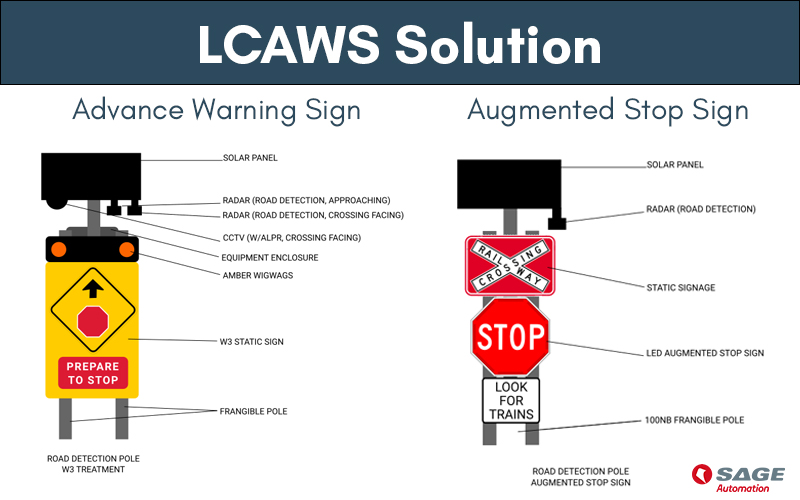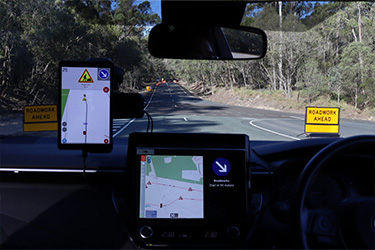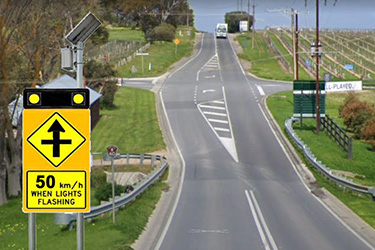3 technologies improving road safety in Australia
SAGE Automation, Published: December 20, 2023 - Updated: December 20, 2023 (6 min read)
Many high-profile technologies are transforming our daily lives and capturing the world's attention, but it's often the less-heralded innovations that hold the greatest potential for impactful change.
In this blog, we’ll be exploring three smart city technologies – RJAWS, LCAWS, and LiDAR – paving the way for major improvements in road safety that have the potential to save countless lives.
Are you interested in learning more about this topic? Gain access to our on-demand webinar.
1. Rural Junction Active Warning System (RJAWS)
Less than 15% of Australia’s population live in rural areas, but deaths on rural and regional roads are disproportionately high, accounting for almost two-thirds of the 2022 road toll. There is a clear need to improve safety on rural and regional roads on a major scale – but addressing a problem of this scale is difficult.
Enter – RJAWS.
RJAWS warns motorists ahead of time that they are approaching a safety hazard.
Developed in conjunction with the Centre for Automotive Safety Research (CASR), the Rural Junction Active Warning System (RJAWS) is a technology-driven solution aimed at reducing hazards at rural junctions and minimising harm in the event of a crash.
Particularly useful on roads where other environmental hazards such as crests or turns impact visibility, RJAWS warns drivers approaching junctions on high-speed rural roads that another vehicle is approaching or turning at the junction.
Utilising a traditional wig-wag light combined with radar sensors, RJAWS works by activating flashing warning lights installed on give way and stop signs to reduce inattention and complacency of road users.
By only flashing when another vehicle is approaching in the other direction, the solution aims to remove the complacency associated with passive, ‘always on’ lighting solutions.
SAGE Automation, in conjunction with CASR and the Department for Infrastructure and Transport, recently developed RJAWS Lite – a solar-powered alternative that enables deployment on a mass scale thanks to cost-effective installation and subsequent monitoring.
RJAWS Lite is currently trialling in the City of Onkaparinga in South Australia.
2. Level Crossing Advance Warning System (LCAWS)
Level crossings between trains and vehicles also present a significant hazard on Australian roads. Collisions resulting in serious injuries and fatalities are common and have far-reaching impacts on local communities. Between 2001 and 2021 there were 164 collisions at level crossings in New South Wales, an average collision frequency of one incident every six weeks.
The Level Crossing Advance Warning System (LCAWS), developed by SAGE Automation in conjunction with Transport for NSW and the Australian Trail Track Corporation, utilises innovative IoT hardware to enhance driver safety at level crossings. LCAWS features solar-powered advance warning signs and augmented stop signs, which can be deployed together or individually at a site.

The LCAWS solution includes the advance warning sign (left) and augmented stop sign.
The advance warning signs utilise orange flashing wig-wag lights that notify approaching motorists who are not slowing down that they need to stop at the level crossing. The augmented stop signs have red LED lights constantly illuminated during daylight hours to increase driver awareness of the stop sign at the level crossing and also flash if an approaching motorist is not slowing down.
LCAWS has next-gen remote monitoring capabilities, is vehicle-to-everything (V2X) ready, and enables lower lifecycle costs than current treatment options available on the market.
3. Light Detection and Ranging (LiDAR)
You’ve heard of sonar (sound navigation and ranging) and radar (radio direction and ranging), but LiDAR (light detection and ranging) is the next evolution of depth-sensing technology that has some exciting use cases.
LiDAR enables detailed 3D visualisations of an environment as well as objects or people moving in an environment through sensors that utilise laser light. The technology can be harnessed to improve road experiences through enhanced monitoring capabilities and to gain real-time data analytics and insights across road networks.
LiDAR technology provides anonymised real-time visualisations and data via light detection technology.
Modern LiDAR enables you to differentiate between a car, pedestrian, and cyclist, and even at what speed and direction they are going in, enabling unprecedented visibility. The technology can also be used to gather secure and anonymised data to drive data-driven decisions, enhance efficiency, and improve incident response times.
Technology such as LiDAR, Cooperative Intelligent Transport Systems (C-ITS), and the Sydney Coordinated Adaptive Traffic System (SCATS) are currently hot topics among ITS professionals.
Conclusion
These three technologies only touch the surface of the exciting safety and network management solutions being developed right here in Australia by SAGE Automation’s smart cities team. If you’d like to learn more about RJAWS, LCAWS and LiDAR, watch our on-demand webinar presented by SAGE’s National Manager of Smart Cities and Future Mobility, Ashby Martin.









